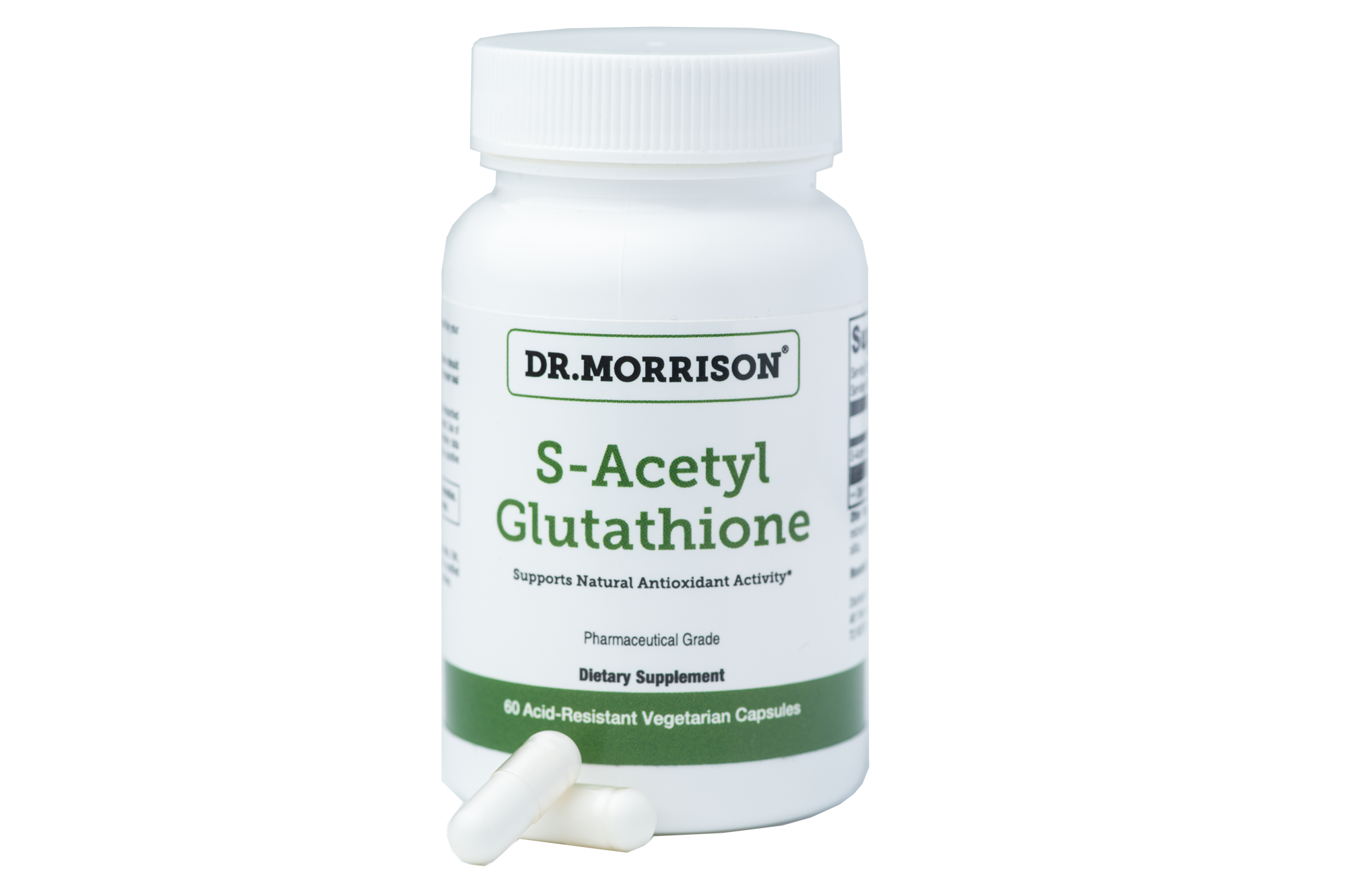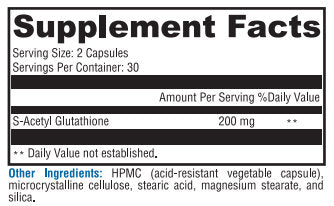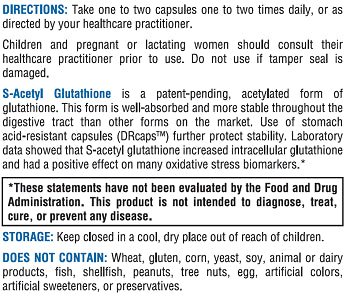S-Acetyl Glutathione
$ 72.00
Size: 60 Vegetarian Capsules
Highly Absorbable Glutathione Provides powerful protection from free radical damage, supports immune function, and promotes detoxification.
Please select all options.
Glutathione is the master intracellular antioxidant in the body, and a crucial part of the liver’s phase II detoxification system. Glutathione regulates reactive small molecules called free radicals, which can damage our cells by stealing electrons from vital molecules like proteins, DNA, and cell membranes. Glutathione supports total-body health by:
- Protecting Against Intracellular Oxidative Stress by Neutralizing Free Radicals*
- Promoting the Antioxidant Activity of Vitamins C and E*
- Supporting a Healthy Immune System and White Blood Cell Function*
- Supporting Amino Acid Metabolism and Transport*
- Protecting Energy-Producing Mitochondria*
- Enhancing Detoxification, especially of Pesticides, Mold, Mercury, Cigarettes, and Air Pollution.*[1-4]
Diverse conditions have been associated with depleted glutathione, including cardiovascular disease, memory changes, cancer, liver diseases, diabetes, hypertension, infertility, autoimmunity, HIV, Parkinson’s disease, and aging.
High-normal levels of gamma-glutamyl transferase (GGT) and low-normal levels of total bilirubin on routine lab work may suggest glutathione depletion and excess oxidative stress.*[6-8] (Speak with a medical professional to interpret your labs in the context of your overall health.)
*These statements have not been evaluated by the FDA and are not intended to treat or cure any disease.
This acetylated form of glutathione is well-absorbed and more stable throughout the digestive tract than other available products. Acetylation ensures maximum potency by preventing glutathione from becoming oxidized in the gut. Our S-Acetyl-Glutathione uses specialized stomach acid-resistant capsules to further protect stability. Laboratory data shows that S-acetyl glutathione increases intracellular glutathione and has a positive effect on oxidative stress biomarkers.9 Our patients love this odorless formulation, with results you can feel!
2 CAPSULES PER SERVING
S-Acetyl Glutathione 200 mg
Other Ingredients: Acid-resistant capsule (hypromellose, gellan gum, and water), microcrystalline cellulose, stearic acid, magnesium stearate, and silica.
FORMULATED TO EXCLUDE: Wheat, gluten, corn, yeast, soy, animal and dairy products, fish, shellfish, peanuts, tree nuts, egg, sesame, GMOs, artificial colors, artificial sweeteners, and artificial preservatives.
Take one to two capsules one to two times daily, or as directed by your healthcare professional.
Caution: Individuals taking medication should discuss potential interactions with their healthcare professional.
Methylmercury (MeHg) toxicity may vary widely despite similar levels of exposure. This is hypothetically related to genetic differences in enzymes metabolizing MeHg. MeHg causes oxidative stress in experimental models but little is known about its effects on humans. The aims of the present study was to evaluate the effects of polymorphisms in glutathione (GSH)-related genes (GSTM1, GSTT1, GSTP1 and GCLM) on Hg concentrations in blood and hair, as well as MeHg-related effects on catalase (CAT) and glutathione-peroxidase (GPx) activity and GSH concentrations. Study subjects were from an Amazonian population in Brazil chronically exposed to MeHg from fish. Hg in blood and hair were determined by ICP-MS, CAT, GPx and GSH were determined by spectrophotometry, and multiplex PCR (GSTM1 and GSTT1) and TaqMan assays (GSTP1 and GCLM) were used for genotyping. Mean Hg concentrations in blood and hair were 48±36 μg/L and 14±10 μg/g. Persons with the GCLM-588 TT genotype had lower blood and hair Hg than did C-allele carriers (linear regression for Hg in blood β=-0.32, p=0.017; and hair β=-0.33; p=0.0090; adjusted for fish intake, age and gender). GSTM1*0 homozygous had higher blood (β=0.20; p=0.017) and hair Hg (hair β=0.20; p=0.013). Exposure to MeHg altered antioxidant status (CAT: β=-0.086; GSH: β=-0.12; GPx: β=-0.16; all p<0.010; adjusted for gender, age and smoking). Persons with GSTM1*0 had higher CAT activity in the blood than those with GSTM1. Our data thus indicate that some GSH-related polymorphisms, such as GSTM1 and GCLM may modify MeHg metabolism and Hg-related antioxidant effects.
The primary pathway of the detoxification of aflatoxin (AF) metabolites occurring at the end of phase-1 biotransformation is glutathione (GSH) conjugation via glutathione-S-transferase (GST) enzyme in phase-2. In this study, the activity of Nigella sativa seeds (NS) and thymoquinone (TQ) on phase-2 detoxification pathways of AF was investigated in light of GSH, GST alpha-3 (GSTA3), and AFB1-DNA adducts detected by the immunohistochemical method in broilers' livers. One-hundred twenty chickens at one-day-old were divided into six groups as the control (CNT), AF, TQ, NS, AF + TQ, and AF + NS groups and fed for 28 days. AF, TQ, and NS were added to the relevant diets at 2 mg/kg, 300 mg/kg, and 5%, respectively. The administration of AF alone strongly stimulated the formation of AFB1-DNA adduct and reduced GSH and GSTA3 levels in hepatocytes (p < 0,01). In contrast, TQ and NS were found to reduce significantly the amount of AFB1-DNA adducts in AF + TQ and AF + NS groups (p < 0,01). We concluded that NS and TQ achieved this by increasing GSH and GSTA3 levels (p < 0,01) thanks to their antioxidant properties, and hence detoxifying the reactive metabolites of AF. Also, we consider that the AFB1-DNA adduct constituted in 28 days can be used as a biomarker for exposure to AF in broilers.




